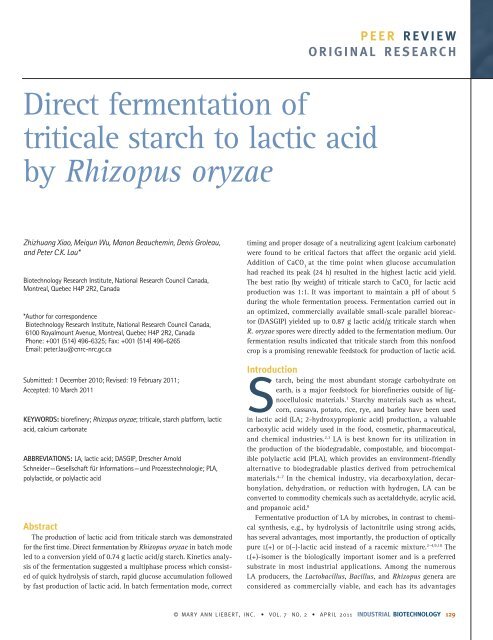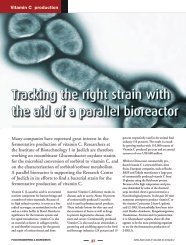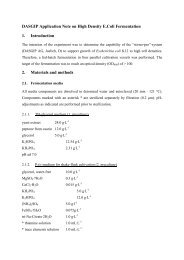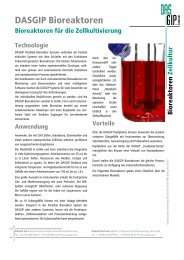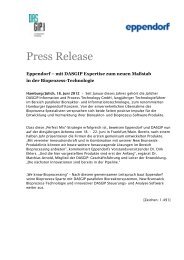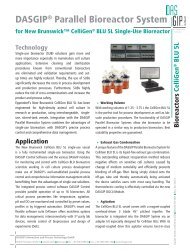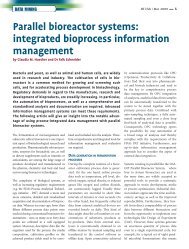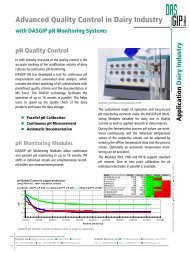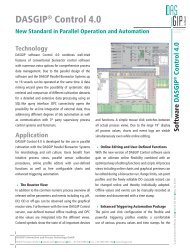Rhizopus oryzae - DASGIP
Rhizopus oryzae - DASGIP
Rhizopus oryzae - DASGIP
Create successful ePaper yourself
Turn your PDF publications into a flip-book with our unique Google optimized e-Paper software.
Direct fermentation of<br />
triticale starch to lactic acid<br />
by <strong>Rhizopus</strong> <strong>oryzae</strong><br />
Zhizhuang Xiao, Meiqun Wu, Manon Beauchemin, Denis Groleau,<br />
and Peter C.K. Lau*<br />
Biotechnology Research Institute, National Research Council Canada,<br />
Montreal, Quebec H4P 2R2, Canada<br />
* Author for correspondence<br />
Biotechnology Research Institute, National Research Council Canada,<br />
6100 Royalmount Avenue, Montreal, Quebec H4P 2R2, Canada<br />
Phone: +001 (514) 496-6325; Fax: +001 (514) 496-6265<br />
Email: peter.lau@cnrc-nrc.gc.ca<br />
Submitted: 1 December 2010; Revised: 19 February 2011;<br />
Accepted: 10 March 2011<br />
KEYWORDS: biorefinery; <strong>Rhizopus</strong> <strong>oryzae</strong>; triticale, starch platform, lactic<br />
acid, calcium carbonate<br />
ABBREVIATIONS: LA, lactic acid; <strong>DASGIP</strong>, Drescher Arnold<br />
Schneider — Gesellschaft für Informations — und Prozesstechnologie; PLA,<br />
polylactide, or polylactic acid<br />
Abstract<br />
The production of lactic acid from triticale starch was demonstrated<br />
for the first time. Direct fermentation by <strong>Rhizopus</strong> <strong>oryzae</strong> in batch mode<br />
led to a conversion yield of 0.74 g lactic acid/g starch. Kinetics analysis<br />
of the fermentation suggested a multiphase process which consisted<br />
of quick hydrolysis of starch, rapid glucose accumulation followed<br />
by fast production of lactic acid. In batch fermentation mode, correct<br />
p e e r r e V I e W<br />
o r I g I N a l r e s e a r c h<br />
timing and proper dosage of a neutralizing agent (calcium carbonate)<br />
were found to be critical factors that affect the organic acid yield.<br />
Addition of CaCO 3 at the time point when glucose accumulation<br />
had reached its peak (24 h) resulted in the highest lactic acid yield.<br />
The best ratio (by weight) of triticale starch to CaCO 3 for lactic acid<br />
production was 1:1. It was important to maintain a pH of about 5<br />
during the whole fermentation process. Fermentation carried out in<br />
an optimized, commercially available small-scale parallel bioreactor<br />
(<strong>DASGIP</strong>) yielded up to 0.87 g lactic acid/g triticale starch when<br />
R. <strong>oryzae</strong> spores were directly added to the fermentation medium. Our<br />
fermentation results indicated that triticale starch from this nonfood<br />
crop is a promising renewable feedstock for production of lactic acid.<br />
Introduction<br />
Starch, being the most abundant storage carbohydrate on<br />
earth, is a major feedstock for biorefineries outside of lignocellulosic<br />
materials. 1 Starchy materials such as wheat,<br />
corn, cassava, potato, rice, rye, and barley have been used<br />
in lactic acid (LA; 2-hydroxypropionic acid) production, a valuable<br />
carboxylic acid widely used in the food, cosmetic, pharmaceutical,<br />
and chemical industries. 2,3 LA is best known for its utilization in<br />
the production of the biodegradable, compostable, and biocompatible<br />
polylactic acid (PLA), which provides an environment-friendly<br />
alternative to biodegradable plastics derived from petrochemical<br />
materials. 4–7 In the chemical industry, via decarboxylation, decarbonylation,<br />
dehydration, or reduction with hydrogen, LA can be<br />
converted to commodity chemicals such as acetaldehyde, acrylic acid,<br />
and pro panoic acid. 8<br />
Fermentative production of LA by microbes, in contrast to chemical<br />
synthesis, e.g., by hydrolysis of lactonitrile using strong acids,<br />
has several advantages, most importantly, the production of optically<br />
pure L(+) or D(–)-lactic acid instead of a racemic mixture. 2–4,9,10 The<br />
L(+)-isomer is the biologically important isomer and is a preferred<br />
substrate in most industrial applications. Among the numerous<br />
LA producers, the Lactobacillus, Bacillus, and <strong>Rhizopus</strong> genera are<br />
considered as commercially viable, and each has its advantages<br />
© mary ann liebert, inc. • Vol. 7 no. 2 • april 2011 INdustrIal BIotechNology 129
peer reVIeW<br />
and disadvantages. 4 Unlike the lactobacilli, LA-producing <strong>Rhizopus</strong><br />
strains (R. <strong>oryzae</strong>, R. arrhizus) generate L(+)-LA as a sole isomer of<br />
LA. 11,12 In addition, the <strong>Rhizopus</strong> fungi naturally produce the amylolytic<br />
enzymes for starch saccharification; they require few complex<br />
nutrients and only a small amount of inorganic salts for growth;<br />
they are tolerant to low pHs; and fungal biomass is easier to separate<br />
from the fermentation broth than bacterial biomass, thus facilitating<br />
downstream processes. 12,13<br />
As the first human-made hybrid crop of durum wheat (Triticum<br />
spp.) and rye (Secale spp.), the century-old triticale (X Triticosecale<br />
Wittmack) remains a largely unexplored crop, as its grain and forage<br />
are used primarily as animal feed. 14–16 Triticale is generally known<br />
for its adaptability to unfavorable soils, drought tolerance, cold<br />
hardiness, disease resistance, and low-input requirements. Canadian<br />
spring (e.g., Carman, Pronghorn, and AC Ultima) and winter varieties<br />
(e.g., Pika and Bobcat) have superior adaptation to stress conditions<br />
such as drought, marginal, or acidic soils. 14,16 Some 3 million acres of<br />
triticale are projected to be grown in the Canadian Prairies by 2015<br />
(Canadian Triticale Biorefinery Initiative; www.ctbi.ca). Like other<br />
cereals, triticale is characterized by high starch and other carbohydrate<br />
content. Total starch levels in triticale are equal to or higher<br />
than for wheat. 16 Triticale grain dry matter contains 62.4%–70.9%<br />
starch, a content that is dependent upon cultivar and year. 17 A recent<br />
scanning electron microscopy study of triticale starch granules during<br />
endosperm and seed development indicated unique and inherent<br />
structures, such as channels or pores that may facilitate the flow of<br />
hydrolytic enzymes into the granule matrix. 18 In addition, triticale<br />
starch has the apparent advantages of low phenolic acids content<br />
that otherwise negatively impacts starch hydrolysis, and a lower<br />
gelatinization temperature (of 65–68°C) compared to those of barley,<br />
wheat, and corn (in the range of 72–75°C; personal communication,<br />
T. Vasanthan, University of Alberta).<br />
Triticale starch is envisaged to provide an important carbohydrate<br />
platform for a biorefinery value chain. In the present work, the feasibility<br />
of LA production from triticale starch was assessed via fungal<br />
fermentation by R. <strong>oryzae</strong> sb NRRL 29086 in a “direct,” or singlestep<br />
mode, otherwise known as simultaneous saccharification and<br />
fermentation (SSF; for reviews 3,9,12 ). We examined the effects of spore<br />
inoculum size, temperature, and addition of calcium carbonate on the<br />
production of LA in batch fermentations and compared the yields to<br />
those obtained in a <strong>DASGIP</strong> parallel bioreactor system.<br />
Material & methods<br />
TRITICALE STARCH And AnALYSIS<br />
Starch of 99% purity prepared from Triticale var. AC Ultima, a<br />
Canadian winter cultivar, was kindly supplied by Dr. Thavaratnam<br />
Vasanthan (University of Alberta) and Dr. Hong Qi (Alberta Agriculture<br />
and Rural Development). The high-purity starch (
1×10 4 per mL. One gram of sterile calcium carbonate powder was<br />
added to the culture medium at 0, 16, 20, 24, and 40 h during the<br />
fermentation at 28°C. To determine the effect of CaCO 3 dosage on LA<br />
production, different amounts of CaCO 3 were added to the medium<br />
24 h after start of the fermentation. Fermentation without addition of<br />
CaCO 3 was used as control. Each condition was carried out in duplicate.<br />
Samples taken at different time points were subjected to analysis<br />
for glucose and LA by HPLC and pH measurement.<br />
FERMEnTATIOn In dASGIP PARALLEL BIOREACTOR<br />
For initial scale-up of the fermentation, a 2 L <strong>DASGIP</strong> parallel bioreactor<br />
system (<strong>DASGIP</strong> BioTools, Shrewsbury, Massachusetts, USA)<br />
was used. R. <strong>oryzae</strong> spores were inoculated into 1 000 mL of Vogel<br />
medium containing 3% (w/v) triticale starch at a final spore concentration<br />
of 1×10 4 per mL. Initial pH of the fermentation medium was<br />
adjusted to 5.0 ± 0.1 by addition of 28% NH 4 OH. The fermentation was<br />
performed at 28°C. The dissolved oxygen was maintained by fixing<br />
the agitation rate at 250 rpm and the inlet-gas flow rate at 0.1 vvm<br />
(L/min). To avoid foaming, 200 µL of antifoam agent Mazu® DF 204<br />
(BASF, Mount Olive, New Jersey, USA) was added to the medium.<br />
Results<br />
The effect of temperature on the conversion of triticale starch to<br />
LA by the R. <strong>oryzae</strong> strain was first determined over four temperature<br />
points; the highest yield of LA at two selected time points (24 h and<br />
48 h) was obtained at 28°C (Figure 1). Inoculum size (spores/mL) also<br />
affected the yield of LA, the highest obtained when the number of<br />
R. <strong>oryzae</strong> spores was 1×10 4 /mL after inoculation of flasks containing<br />
3% (w/v) triticale starch (Figure 2). The product yield decreased<br />
by 23% when either a higher inoculum size (1×10 6 spores/mL) or a<br />
much lower inoculum size (400 spores/mL) was used; however, good<br />
yields were also obtained with an inoculum of 2 000 spores/mL and a<br />
fermentation duration of 72 h.<br />
Yield of lactic acid (g/L)<br />
10<br />
9<br />
8<br />
7<br />
6<br />
5<br />
4<br />
3<br />
2<br />
1<br />
0<br />
■ 24 h<br />
■ 48 h<br />
24 28 30 32<br />
Temperature (°C)<br />
Figure 1. Effect of temperature on the fermentation of triticale starch<br />
into lactic acid by R. <strong>oryzae</strong>. Each data point represents mean ± SD<br />
(n = 3). The p value of the data point for 28°C/48 h, compared to<br />
others, is
peer reVIeW<br />
A<br />
Yield of lactic acid (g/L)<br />
B<br />
Glucose accumulation (g/L)<br />
C<br />
pH<br />
25<br />
20<br />
15<br />
10<br />
5<br />
no addition of CaCO3<br />
1 g of CaCO3 at 0 h<br />
1 g of CaCO3 at 16 h<br />
■ 1 g of CaCO3 at 20 h<br />
▲ 1 g of CaCO3 at 24 h<br />
● 1 g of CaCO3 at 40 h<br />
0 0 10 20 30 40 50 60 70<br />
18<br />
16<br />
14<br />
12<br />
10<br />
8<br />
6<br />
4<br />
2<br />
Fermentation time (h)<br />
0<br />
0 10 20 30 40 50 60 70<br />
Fermentation time (h)<br />
7<br />
6<br />
5<br />
4<br />
Figure 4. (A) Lactic acid yield as a function of CaCO3 addition at various<br />
times; (B) glucose accumulation profile; (C) pH change during<br />
the course of triticale starch fermentation to lactic acid by R. <strong>oryzae</strong>.<br />
132 INdustrIal BIotechNology april 2011<br />
no addition of CaCO3<br />
1 g of CaCO3 at 0 h<br />
1 g of CaCO3 at 16 h<br />
■ 1 g of CaCO3 at 20 h<br />
▲ 1 g of CaCO3 at 24 h<br />
● 1 g of CaCO3 at 40 h<br />
3<br />
no addition of CaCO3<br />
1 g of CaCO3 at 0 h<br />
2 1 g of CaCO3 at 16 h<br />
■ 1 g of CaCO3 at 20 h<br />
1 ▲<br />
●<br />
1 g of CaCO3 at 24 h<br />
1 g of CaCO3 at 40 h<br />
0<br />
0 10 20 30 40 50 60 70<br />
Fermentation time (h)<br />
(after 40 h), glucose consumption tapered off, while LA accumulation<br />
reached a plateau.<br />
When a larger inoculum size of 1×10 6 spores/mL was used,<br />
observed LA production occurred earlier than in cases when smaller<br />
inocula were used (data not shown); both glucose accumulation and<br />
LA production were lower (this latter effect shown in Figure 1).<br />
We examined next the influence of a time-course addition of<br />
the neutralizing agent CaCO 3 on LA production. The results showed<br />
that timing greatly influenced LA production (Figure 4A, Table 1),<br />
glucose accumulation (Figure 4B), and pH values in the fermentation<br />
medium (Figure 4C ). Compared to the control where no CaCO 3 was<br />
added, CaCO 3 supplementation during the 20–40 h period (phases 3,<br />
4, and 5) increased LA production; however, addition of CaCO 3 at<br />
0 h and 16 h (phase 1 and 2) raised the pH to about 6.0 (Figure 4C ),<br />
causing a delay as well as reduced glucose accumulation (Figure 4B )<br />
and, hence, decreased LA production (Figure 4A, Table 1). CaCO 3<br />
supplementation at 24 h yielded 74.0 ± 2.1 g LA from 100 g starch,<br />
thus leading to an 80% increase in yield compared to when CaCO 3<br />
was added immediately at the beginning of the fermentation.<br />
The effect of CaCO 3 dosage (starch-to-CaCO 3 ratio) and quantity<br />
of CaCO 3 on LA production was also examined (Table 2). The results<br />
indicated that the best yield of LA was obtained at the starch-to-<br />
CaCO 3 ratio (by weight) of 1:1. Adding more CaCO 3 provided no additional<br />
benefit. However, a low CaCO 3 dosage (starch-to-CaCO 3 ratio of<br />
6:1) was still beneficial since that fermentation produced 41% more<br />
LA than without the neutralizing agent.<br />
Instead of shake flasks, the <strong>DASGIP</strong> parallel bioreactor system was<br />
employed to provide a comparison of LA yield. Initial experiments<br />
examined the effect of temperature (30°C versus 28°C), rate of agitation,<br />
inoculum concentration and format (spores versus mycelium),<br />
aeration level, and influence of sparger design (Rushton-type impeller),<br />
as well as the use of chemical antifoam (Mazu DF204). After several<br />
initial runs, examples of promising yields of LA were determined<br />
(Table 3). LA production reached 86.7±4.3 g from 100 g starch after<br />
72 h of fermentation performed in a 2 L-scale <strong>DASGIP</strong> system. With<br />
Table 1. Time effect of CaCO3 addition on the<br />
production of lactic acid by R. <strong>oryzae</strong><br />
LA yield (g/L) LA yield (g/100 g starch)<br />
Control (no CaCO3) 14.9±1.5 49.7±5.0<br />
+ CaCO3 at 0 hr 12.3±0.1 41.0±0.3*<br />
+ CaCO3 at 16 hr 12.8±0.1 42.7±0.3a + CaCO3 at 20 hr 19.1±0.3 63.7±1.0**<br />
+ CaCO3 at 24 hr 22.2±0.7 74.0±2. 1 **<br />
+ CaCO3 at 40 hr 20.3±0.1 67.7±0.3**<br />
Note: Ratio of CaCO to starch = 1:3.<br />
3<br />
Each data point represents mean ± SD (n = 3).<br />
anot significant; *, p value < 0.05; **, p value < 0.01; versus control
a fixed agitation rate of 250 rpm, aeration rates ranging between<br />
0.03 and 0.1 L/min did not significantly affect the LA yield. However,<br />
inoculum size was found to be important, as observed previously in<br />
shake flasks experiments.<br />
Discussion<br />
This study is a benchmarking effort to assess the feasibility of LA<br />
production from triticale starch via fungal fermentation employing<br />
an R. <strong>oryzae</strong> strain, giving LA yields from starch (0.74–0.87 g/g)<br />
that are competitive with other starchy materials. Yu and Hang 11<br />
studied the direct fermentation of several starchy agricultural commodities<br />
and found the following order of merit in terms of LA yield:<br />
rice > corn > cassava > barley > oats. The yields of LA and mode<br />
of production by various starchy materials are compared in Table 4.<br />
Rice and corn yielded about 45 g and 35 g of LA from 100 g starch,<br />
respectively, when <strong>Rhizopus</strong> spores were used as inoculum in the flask<br />
experiments. 11,23 An oat starch conversion yield of 68 g LA/100 g<br />
starch was achieved in 10 L airlift bioreactors when spores were<br />
used as inoculum. 24 Sweet potato starch produced 72 g LA from 100<br />
Table 2. Effect of CaCO 3 dosage on the production of lactic acid by R. <strong>oryzae</strong><br />
peer reVIeW<br />
g starch in 5 L stirred bioreactors when freshly prepared R. <strong>oryzae</strong><br />
mycelium from spores was used. 25 Up to 85 g LA was produced from<br />
100 g corn starch in 3 L airlift bioreactors when the starch was prehydrolyzed<br />
by α-amylase, also using freshly prepared mycelium from<br />
spores as inoculum. 26 In the <strong>DASGIP</strong> bioreactor system described<br />
herein, our study shows that simultaneous saccharification and fermentation<br />
of triticale starch by R. <strong>oryzae</strong> spores produced 86.7±4.3 g<br />
LA from 100 g starting starch material — a yield that was about 10%<br />
higher than those obtained in shake flasks.<br />
LA fermentations by <strong>Rhizopus</strong> strains have been carried out at<br />
temperatures in the range of 27°C to 35°C. 12 The optimal temperature<br />
for LA production by R. <strong>oryzae</strong> strain NRRL 29086 was 28°C. Yu and<br />
Hang 11 reported that increasing the inoculum size of R. <strong>oryzae</strong> strain<br />
NRRL 395 from an initial level of 1×10 5 spores/mL to 3×10 5 spores/<br />
mL or more did not improve the LA yield obtained with a number<br />
of agricultural commodities including barley, oat, cassava, corn, and<br />
rice. However, our results indicated that R. <strong>oryzae</strong> inoculum size<br />
significantly influenced LA production, 1×10 4 spores/mL being the<br />
optimal concentration.<br />
CaCO3 dosage (g/ 100 mL) 0 0.5 1 2 3 6<br />
Ratio of starch to CaCO3 - 6 3 1.5 1 0.5<br />
Yield of lactic acid (g/L) 12.8±2.7 18.1±0.5 19.8±0.2 20.2±0.1 21.0±0.5 20.8±1.8<br />
Yield of lactic acid (g/100 g starch) 42.7±9 60.3±1.7* 66.0±0.7* 67.3±0.3** 70.0±1.7** 69.3±6*<br />
Note: Each data point represents mean ± SD (n = 3). The significance is calculated relative to the production of LA without CaCO3 (*, p value < 0.05; **, p value < 0.01).<br />
Table 3. Lactic acid fermentation of triticale starch by R. <strong>oryzae</strong> using a 1L <strong>DASGIP</strong> parallel bioreactor<br />
system<br />
Inoculum size (spores/mL) Agitation speed (rpm) Aeration rate (L/min) Lactic acid yield (g from 100 g starch)<br />
2.4 × 103 250 0.1 86.7 ± 4.3<br />
1.0 × 104 250 0.1 82.3 ± 4.1<br />
1.0 × 104 250 0.03 81.0 ± 4.0<br />
Note: Each data point represents mean ± SD (n = 4).<br />
Table 4. Comparison of results of the present work to previous reports<br />
Carbon source/<br />
feedstock<br />
Inoculum type Fermentation vessel<br />
Yield of lactic acid<br />
(g/L)<br />
Yield of lactic acid<br />
(g/100 g starch)<br />
Reference<br />
triticale starch spore flask 22 74 this study<br />
triticale starch spore <strong>DASGIP</strong> bioreactor 26.1 87 this study<br />
rice spore flask 45 45 11<br />
corn spore flask unknown 35 23<br />
oat starch spore airlift bioreactor 51.7 68 24<br />
sweet potato starch mycelium stirred bioreactor 43.3 72 25<br />
corn starch mycelium airlift bioreactor 102 85 26<br />
© mary ann liebert, inc. • Vol. 7 no. 2 • april 2011 INdustrIal BIotechNology 133
peer reVIeW<br />
Little information is known about the kinetics of the directed<br />
fermentation of starch to LA by R. <strong>oryzae</strong>. In our study, the profiles<br />
obtained for starch, glucose accumulation, LA production, and pH<br />
during the entire fermentation process suggested that LA production<br />
proceeded according to the following: First, rapid hydrolysis of the<br />
starch provided nutrients and energy for fungal growth and for the<br />
amylolytic enzyme production (phase 1 and 2). Second, fast accumulation<br />
of glucose was observed due to amylolytic enzymes secreted by<br />
the fungus (phase 2 and 3). Third, rapid production occurred of LA<br />
that was subsequently secreted into the fermentation medium (phase<br />
4). The kinetics of LA production appeared similar when a much<br />
higher inoculum size (1×10 6 spores/mL) was used compared to the<br />
optimal inoculum size (1×10 4 spores/mL). However, the use of larger<br />
inoculum sizes led to earlier production of LA, although yields were<br />
lower. It is assumed here that cultures that were started with a larger<br />
inoculum size grew faster and required more energy for growth than<br />
those started with a smaller inoculum size. Hence, determination of<br />
the appropriate inoculum size appears essential for optimal production<br />
of LA by R. <strong>oryzae</strong>. As expected, pH dropped during the fermentation<br />
as LA was being produced (Figure 3B ). Among several neutralizing<br />
agents, including sodium hydroxide, ammoniacal solution, and<br />
sodium bicarbonate, CaCO 3 was found to be most effective for LA<br />
production from potato starch via R. <strong>oryzae</strong>. 25 Several other studies<br />
involved the use of CaCO 3 , as well as experimenting on the time of<br />
addition, dosage, and ratio of fermentation substrate-to-CaCO 3 . 11,23,26–29<br />
Our results indicated that time of addition together with dosage of<br />
CaCO 3 was an important factor for LA production. Addition of CaCO 3<br />
immediately at the beginning of fermentation was not a good strategy,<br />
as it actually reduced LA yields compared to the control conditions.<br />
Most of the LA yield occurred between 24 and 40 h (phase 4 and 5).<br />
Addition of CaCO 3 at the 24 h time point, at which time glucose accumulation<br />
had reached its peak, resulted in the highest LA production<br />
(Table 1). The best ratio (by weight) of triticale starch-to-CaCO 3 for LA<br />
production was 1:1. With the addition of the right amount of CaCO 3 at<br />
the right time, the pH of the fermentation broth could be maintained<br />
around 5 during the whole fermentation process.<br />
The <strong>DASGIP</strong> parallel bioreactor offers various features for automated<br />
control while permitting accelerated process development. 30 In this<br />
study, LA production at the 2 L scale under a set of optimized conditions<br />
exceeded that observed in shake flasks. However, further challenges still<br />
need to be met, such as higher LA yields (g/L) and a shorter fermentation<br />
cycle. In this context, further optimization of key parameters, such as the<br />
use, or not, of fresh mycelium needs to be considered. Also, to meet the<br />
cost issues associated with starch processing, triticale flour and whole<br />
grains should be considered in future experiments.<br />
In conclusion, triticale offers an interesting prospect of a nonfood crop<br />
for an important carbohydrate platform in a biorefinery value chain.<br />
A C K n O w L E d G M E n T S<br />
Funding of this work was provided by the Canadian Triticale<br />
Biorefinery Initiative (CTBI) of the Agricultural Bioproducts<br />
134 INdustrIal BIotechNology april 2011<br />
Innovation Program of Agriculture and Agri-Food Canada. We thank<br />
members of the CTBI for their continuous support, and John Lu and<br />
Thava Vasanthan for discussion. We are grateful to S. Deschamp for<br />
his expert help in chemical analysis. This manuscript is issued as<br />
NRCC publication number 53354.<br />
R E F E R E n C E S<br />
1. Grull DR, Jetzinger F, Kozich M, Wastyn MM, and Wittenberger R. Industrial<br />
starch platform — Status quo of production, modification and application. In:<br />
Biorefineries — Industrial processes and products. Status quo and future directions.<br />
Kamm B, Gruber PR, and Kamm M (eds), vol 2, 61-95, Wiley-VCH Verlag<br />
GmbH & Co. KGaA, Weinheim (2006).<br />
2. Wee YJ, Kim JN, and Ryu HW. Biotechnological production of lactic acid and its<br />
recent applications. Food Tech Biotechnol 44, 163-172 (2006).<br />
3. John RP, Anisha GS, Nampoothiri KM, and Pandey A. Direct lactic acid fermentation:<br />
Focus on simultaneous saccharification and lactic acid production.<br />
Biotechnol Adv 27, 145-152 (2009).<br />
4. Gruber P, Henton DE, and Starr J. Polylactic acid from renewable resources.<br />
In: Biorefineries — Industrial processes and products. Status quo and future<br />
directions. Kamm B, Gruber PR, and Kamm M (eds), vol 2, 381-407, Wiley-VCH<br />
Verlag GmbH & Co. KGaA, Weinheim (2006).<br />
5. Datta R, and Henry M. Lactic acid: Fecent advances in products, processes, and<br />
technologies — A review. J Chem Technol Biotechnol 81, 1119-1129 (2006).<br />
6. Nampoothiri KM, Nair, NR, and John RP. An overview of the recent developments<br />
in polylactide (PLA) research. Bioresource Technol 101, 8493-8501<br />
(2010).<br />
7. Pang X, Zhuang X, Tang Z, and Chen X. Polylactic acid (PLA): Research,<br />
development and industrialization. Biotechnol J 5, 1125-1136 (2010).<br />
8. Katryniok B, Paul S, and Dumeignil F. Highly efficient catalyst for the decarboxylation<br />
of lactic acid to acetaldehyde. Green Chem 12, 1910-1913 (2010).<br />
9. Reddy G, Altaf Md, Naveena BJ, Ventkateshwar M, and Kumar EV. Amylolytic<br />
bacterial lactic acid fermentation — A review. Biotechnol Adv 26, 22-34 (2008).<br />
10. John RP, Nampoothiri KM, and Pandey A. Fermentative production of lactic<br />
acid from biomass: An overview on process developments and future perspectives.<br />
Appl Microbiol Biotechnol 74, 524-534 (2007).<br />
11. Yu RC and Hang YD. Kinetics of direct fermentation of agricultural commodities<br />
to L(+) lactic acid by <strong>Rhizopus</strong> <strong>oryzae</strong>. Biotechnol Lett 11, 597-600 (1989).<br />
12. Zhang ZY, Jin B, and Kelly JM. Production of lactic acid from renewable<br />
materials by <strong>Rhizopus</strong> fungi. Biochem Eng J 35, 251-263 (2007).<br />
13. Liu Y, Liao W, and Chen S. Co-production of lactic acid and chitin using a<br />
pelletized filamentous fungus <strong>Rhizopus</strong> <strong>oryzae</strong> cultured on cull potatoes and<br />
glucose. J Appl Microbiol 105, 1521-1528 (2008).<br />
14. Salmon DF, Mergoum M, and Gomez-Macpherson H. Triticale production and<br />
management. In: Triticale improvement and production. Mergoum M and<br />
Gomez-Macpherson H. (eds), 27-37; Plant production and protection paper<br />
179, Food and Agriculture Organization of the United Nations, Rome, Italy<br />
(2004).<br />
15. Oettler G. The fortune of a botanical curiosity — Triticale, past, present, and<br />
future. J Agric Sci 143, 329-346 (2005).<br />
16. Triticale Production and Utilization Manual. Alberta Agriculture, Food and Rural<br />
Development (2005).<br />
17. Buresova I, Sedlaclova I, Famera O, and Lipavsky J. Effect of growing conditions<br />
on starch and protein content in triticale grain and amylose content in starch.<br />
Plant Soil Environ 56, 99-104 (2010).<br />
18. Li C-Y, Li W-H, Lee B, Laroche A, Cao L-P, and Lu Z-X. Morphological characterization<br />
of triticale starch granules during endosperm development and seed<br />
germination. Can J Plant Sci 91, 57-67 (2011).
19. Kandil A, Li J, Vasanthan V, Bressler, DC, and Tyler RT. Compositional changes<br />
in whole grain flours as a result of solvent washing and their effect on starch<br />
amylolysis. Food Res Int 44, 167-173 (2011).<br />
20. Henriksson G, Akin DE, Hanlin RT, Rodriguez C, Archibald DD, Rigsby LL, and<br />
Eriksson KL. Identification and retting efficiencies of fungi isolated from<br />
dew-retted flax in the United States and Europe. Appl Environ Microbiol 63,<br />
3950-3956 (1997).<br />
21. Xiao Z, Wang S, Bergeron H, Zhang J, and Lau PCK. A flax-reting endopolygalacturonase-encoding<br />
gene from <strong>Rhizopus</strong> <strong>oryzae</strong>. Antonie van Leeuwenhoek<br />
94, 563-571 (2008) .<br />
22. Smith CS, Salde SJ, Nordheim EV, Cascino JJ, Harris RF, and Andrews JH.<br />
Sources of variability in the measurement of fungal spore yields. Appl Environ<br />
Microbiol 54, 1430-1435 (1988) .<br />
23. Hang YD. Direct fermentation of corn to L (+)-lactic acid by <strong>Rhizopus</strong> <strong>oryzae</strong>.<br />
Biotechnol Lett 11, 299-300 (1989).<br />
24. Koutinas AA, Malbranque F, Wang R, Campbell GM, and Webb C. Development<br />
of an oat-based biorefinery for the production of L (+)-lactic acid by <strong>Rhizopus</strong><br />
<strong>oryzae</strong> and various value-added coproducts. J Agric Food Chem 55, 1755-1761<br />
(2007).<br />
25. Yen HW, Chen TJ, Pan WC, and Wu HJ. Effects of neutralizing agents on lactic<br />
acid production by <strong>Rhizopus</strong> <strong>oryzae</strong> using sweet potato starch. World J<br />
Microbiol Biotechnol 26, 437-441 (2010).<br />
26. Yin P, Nishina N, Kosakai Y, Yahiro K, Park Y, and Okabe M. Enhanced production<br />
of L(+)-lactic acid from corn starch in a culture of <strong>Rhizopus</strong> <strong>oryzae</strong> using<br />
an air-lift bioreactor. J Ferment Bioeng 84, 249-253 (1997).<br />
27. Zhou Y, Domínguez JM, Cao N, Du J, and Tsao GT. Optimization of L-lactic<br />
acid production from glucose by <strong>Rhizopus</strong> <strong>oryzae</strong> ATCC 52311. Appl Biochem<br />
Biotechnol 77-79, 401-407 (1999).<br />
28. Liu Y, Liao W, Liu C, and Chen S. Optimization of L (+)-lactic acid production<br />
using pelletized filamentous <strong>Rhizopus</strong> <strong>oryzae</strong> NRRL 395 Appl Biochem<br />
Biotechnol 131, 844-853 (2006).<br />
29. Huang LP, Jin B, and Lant P. Direct fermentation of potato starch wastewater<br />
to lactic acid by <strong>Rhizopus</strong> <strong>oryzae</strong> and <strong>Rhizopus</strong> arrhizus. Bioproc Biosys Eng 27,<br />
229-238 (2005).<br />
30. Bareither R and Pollard D. A review of advanced small-scale parallel bioreactor<br />
technology for accelerated process development: Current state and future<br />
needs. Biotechnol Prog 27, 2-14 (2010)<br />
peer reVIeW<br />
© mary ann liebert, inc. • Vol. 7 no. 2 • april 2011 INdustrIal BIotechNology 135


